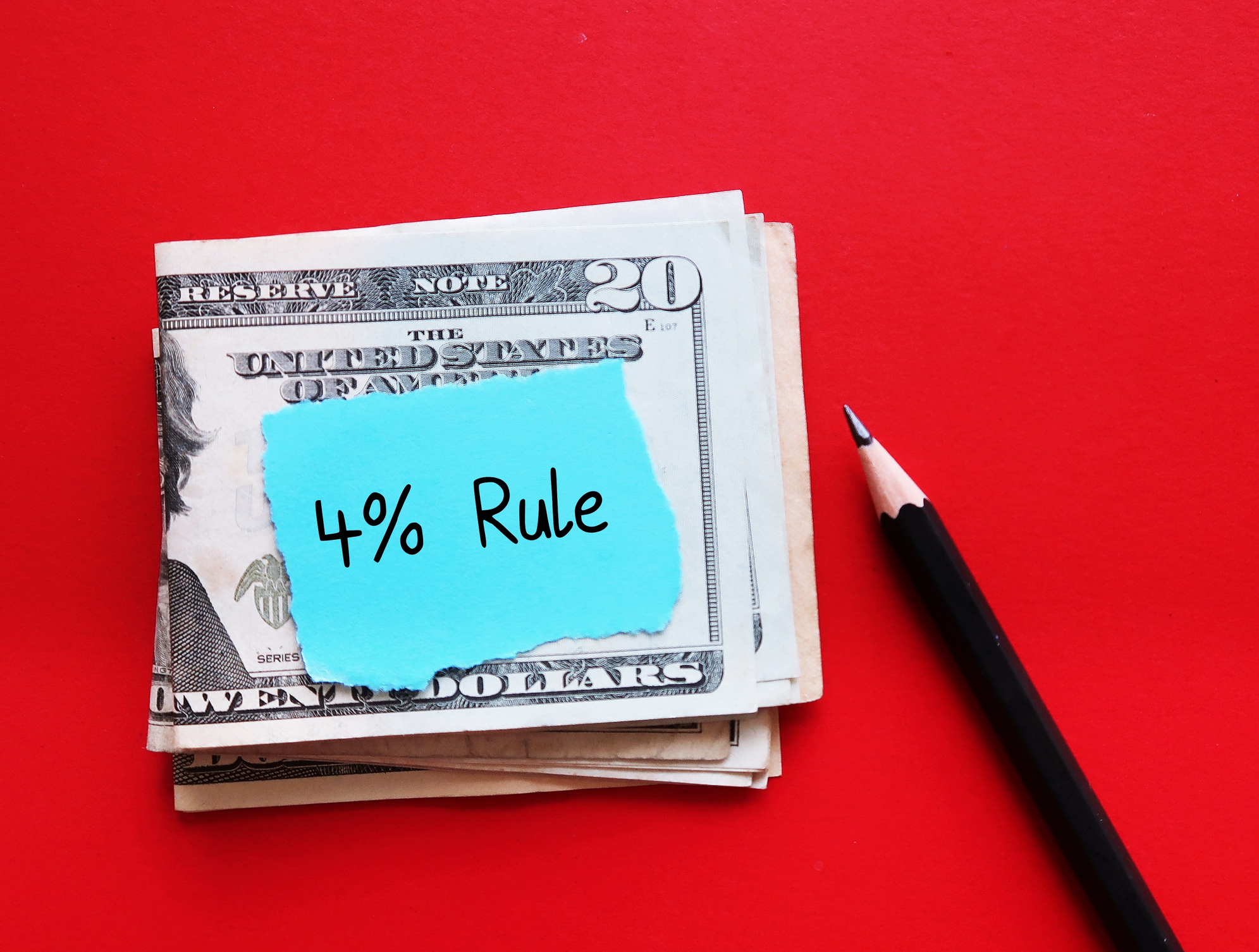The 4% Rule for Retirement Withdrawals Gets an Upgrade
The 4% rule for retirement spending was created over 30 years ago. Things have changed since then. Here's how you can modernize the rule to fit your needs.


When financial adviser William Bengen invented the 4% rule for retirement planning, Beanie Babies were a hot collectible and Forest Gump had just debuted. The rule provides a general guideline for how much to withdraw in retirement safely so you don't outlive your money. But that was in 1994, and it’s fair to ask whether his formula still holds up.
Here's how the 4% rule works. Let’s say you start with a $2.5 million portfolio. In your first year of retirement, you can withdraw 4% of your total balance or $100,000. That sets your baseline. The withdrawal amount increases with the inflation rate each year thereafter. If inflation is 2% in year two, you withdraw $102,000.
In theory, this formula means that “under a worst-case investment scenario, your savings should still last 30 years,” says Karen Birr, manager of retirement consulting at Thrivent in Minneapolis. In practice, however, the formula may require adjusting because Bengen made several assumptions when he devised the rule that don’t always apply today.
From just $107.88 $24.99 for Kiplinger Personal Finance
Become a smarter, better informed investor. Subscribe from just $107.88 $24.99, plus get up to 4 Special Issues

Sign up for Kiplinger’s Free Newsletters
Profit and prosper with the best of expert advice on investing, taxes, retirement, personal finance and more - straight to your e-mail.
Profit and prosper with the best of expert advice - straight to your e-mail.
The 4% rule and markets
First, Bengen assumed that a retirement portfolio would be split approximately 50/50 between stocks and bonds, basing returns on historical market data from 1926 to 1976. “There are some issues with using historic returns,” says Dan Keady, a certified financial planner and senior director of financial planning at TIAA in Charlotte, N.C. For one thing, bond interest rates were higher then, whereas Keady says retirees today could need a higher stock allocation — up to 75% — to generate enough income.
Investing more in stocks in a bear market when the bottom seems nowhere in sight can be tough for retirees to stomach, so another option is to lower the 4% baseline withdrawal rate to “a little over 3%, maybe 3.3%,” says Keady. This means you will need to either accept less income or save for retirement. To generate the same amount of income at 3%, your portfolio would need to be 33% larger.
Longevity challenges the 4% rule
Bengen also assumed that retirement savings should last 30 years to account for longevity risk. Over time, however, life expectancies have risen, and today, savings may need to last 35, even 40 years. This, too, might imply lowering the 4% rate, except some financial advisers say that approach risks too much austerity, especially if markets bounce back. “We commonly see people are so cautious with their spending, they end up with more money three to five years after retiring,” says Sri Reddy, senior vice president for retirement and income at Principal Financial Group in Des Moines, Iowa.
In fact, Bengen himself suggested raising the target rate to 4.5% or even 5% when he observed that many retirees were dying before spending down their savings.
“Having a surplus at the end of life is not a bad thing,” says Birr. “Just make sure it’s something you want.”
However, for some retirees, the "Die With Zero" rule may apply, which encourages them to spend and enjoy their money during their lifetime.
If you’re worried about outliving your savings, Keady suggests transferring part of your portfolio to an annuity for guaranteed lifelong income. An annuity combined with Social Security should deliver enough income to cover essential needs, with the 4% rule applying to your investment portfolio for discretionary spending, like vacations and hobbies. In a bad investing year, discretionary spending can be reduced without affecting the essentials.
Inflation can undermine a 4% approach
When Bengen created the 4% rule, inflation averaged a modest 2% to 3%. While it was recently at 3% as of September, it had hit a more than 40-year high of 9.1% in June 2022. In a high inflationary environment, withdrawing more at the start of retirement to keep pace, particularly when the market is down, can throw retirement planning off track — an effect known as the sequence of returns risk.
Let’s say we have two years of 7% inflation, Keady says. Someone who started withdrawing $100,000 a year would be taking out $114,490 in year three. That’s hard to sustain, as you’ll continue to build off those higher-than-expected withdrawal rates.
One solution is the guardrails, or "Go Live Your Life" rule. Review your portfolio performance and inflation each year, adjusting the withdrawal rate to match your target. If inflation pushes up the baseline withdrawal rate to 6% a year, scale it back.
If a bull market sends your portfolio balance soaring, you may be able to take out less than 3% or 4% with no change in lifestyle. Once you turn 73, required minimum distributions (RMDs) from traditional IRA and 401(k) accounts may force you to withdraw more than you prefer. “The first-year RMD percentage starts at [over 3%] and increases as you get older,” says Birr. Calculating your RMDs can be complex, so consult with a financial adviser if you need help.
Early retirement
If you are among the many people interested in retiring early or the FIRE movement (which stands for financial independence, retire early), the 4% rule may be too aggressive for your needs. Since your retirement will be much longer than average, you must plan early retirement withdrawal strategies for the long haul. And before you leap, consider that a sabbatical may be a smarter move than early retirement.
Spending
Adjusting the withdrawal rate annually also addresses another Bengen assumption: that retirement spending rises linearly, when in fact it fluctuates.
Retirees tend to spend more in the early stages of retirement. “As they get older, spending usually slows down, before possibly picking up again for late-life health care costs,” Reddy says. He prefers that clients allocate more funds initially and adjust their budget later if it appears they might run short. Remember, the 4% rule is only an estimate because everyone’s situation is different, Birr says. “Life events will happen, and you need to be flexible.”
Related Content
Profit and prosper with the best of Kiplinger's advice on investing, taxes, retirement, personal finance and much more. Delivered daily. Enter your email in the box and click Sign Me Up.

David is a financial freelance writer based out of Delaware. He specializes in making investing, insurance and retirement planning understandable. He has been published in Kiplinger, Forbes and U.S. News, and also writes for clients like American Express, LendingTree and Prudential. He is currently Treasurer for the Financial Writers Society.
Before becoming a writer, David was an insurance salesman and registered representative for New York Life. During that time, he passed both the Series 6 and CFP exams. David graduated from McGill University with degrees in Economics and Finance where he was also captain of the varsity tennis team.
- Donna FuscaldoRetirement Writer, Kiplinger.com
- Ellen B. KennedyRetirement Editor, Kiplinger.com
-
 What to expect from the global economy in 2026
What to expect from the global economy in 2026The Kiplinger Letter Economic growth across the globe will be highly uneven, with some major economies accelerating while others hit the brakes.
-
 What You Need to Do With Your 401(k) Before 2025 Is Over
What You Need to Do With Your 401(k) Before 2025 Is OverBefore 2025 ends, check your 401(k) contributions, investments, and catch-up eligibility to lock in this year’s tax savings and employer match.
-
 3 Year-End Tax Moves You Can't Afford to Miss
3 Year-End Tax Moves You Can't Afford to MissDon't miss out on this prime time to maximize contributions to your retirement accounts, do Roth conversions and capture investment gains.
-
 What You Need to Do With Your 401(k) Before 2025 Is Over
What You Need to Do With Your 401(k) Before 2025 Is OverBefore 2025 ends, check your 401(k) contributions, investments, and catch-up eligibility to lock in this year’s tax savings and employer match.
-
 I'm a Tax Attorney: These Are the Year-End Tax Moves You Can't Afford to Miss
I'm a Tax Attorney: These Are the Year-End Tax Moves You Can't Afford to MissDon't miss out on this prime time to maximize contributions to your retirement accounts, do Roth conversions and capture investment gains.
-
 I'm an Investment Adviser: This Is the Tax Diversification Strategy You Need for Your Retirement Income
I'm an Investment Adviser: This Is the Tax Diversification Strategy You Need for Your Retirement IncomeSpreading savings across three "tax buckets" — pretax, Roth and taxable — can help give retirees the flexibility to control when and how much taxes they pay.
-
 I'm Retired With $2.2 Million Saved and Work 2 Retail Shifts a Week for Fun. My Young Colleague Just Got Her Hours Cut. Should I Quit So She Can Have My Shifts?
I'm Retired With $2.2 Million Saved and Work 2 Retail Shifts a Week for Fun. My Young Colleague Just Got Her Hours Cut. Should I Quit So She Can Have My Shifts?Should she quit her job so a struggling young colleague can take her shifts? We asked certified financial planners for advice.
-
 Could an Annuity Be Your Retirement Safety Net? 4 Key Considerations
Could an Annuity Be Your Retirement Safety Net? 4 Key ConsiderationsMore people are considering annuities to achieve tax-deferred growth and guaranteed income, but deciding if they are right for you depends on these key factors.
-
 I'm a Financial Pro: Older Taxpayers Really Won't Want to Miss Out on This Hefty (Temporary) Tax Break
I'm a Financial Pro: Older Taxpayers Really Won't Want to Miss Out on This Hefty (Temporary) Tax BreakIf you're age 65 or older, you can claim a "bonus" tax deduction of up to $6,000 through 2028 that can be stacked on top of other deductions.
-
 Why Playing It Safe in Retirement Is a Big Risk
Why Playing It Safe in Retirement Is a Big RiskFear of losing money could actually cost you in retirement. Find out why being too conservative with your life savings can hurt you and how to stop that from happening.
-
 QUIZ: What Type Of Retirement Saver Are You?
QUIZ: What Type Of Retirement Saver Are You?Quiz What is your retirement savings style? Find out with this quick quiz.